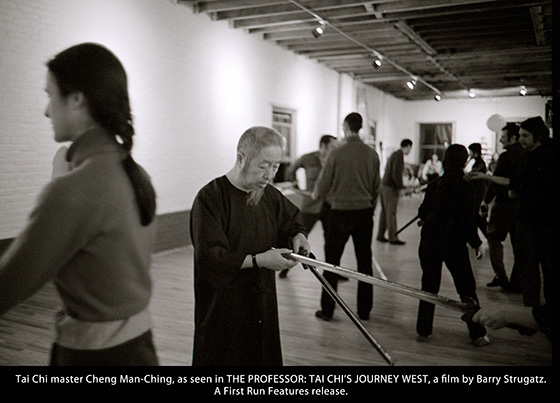The Professor: Tai Chi’s Journey West (First Run Features, 2016)
Collaboration. Tolerance. Innovation. Naturalism. Terms associated with the historically significant teachings of Cheng Man-Ching. Filmmaker Barry Stugartz has crafted a loving and respectful tribute.
“The Professor” as he was known, was the first major Tai Chi master from China to expose a generation of Americans to what until then had been shrouded in secret from Western culture. He felt the Eastern practice of internal arts like Tai Chi should be accessible to all. This was evident in the variety of students who were drawn to his classes in New York City in the mid-1960s. He pioneered teaching the art of Tai Chi as a healing practice, distinct from other martial arts, like Karate.

Cheng himself was a living example of Tai Chi’s healing energy and physical benefits, as he believed it improved his lung function. Likewise one of his students mentions in the documentary Tai Chi alleviated knee pain. Still another, with polio, found meditative release in the sword form. Two of my own sifu’s have similarly exorcised musculoskeletal demons through the assistance of Tai Chi and Qigong.
Director Barry Strugatz carefully builds a chronological journey of Cheng Man-Chin’s time in America, framed by chapters defining characteristics of the art of Tai Chi –naturalism (Daoism, or “the way”), relaxation and simplicity, healing, push hands, chi (energy) and philosophy. The number of former students who participated in the documentary is a testament to Cheng’s impact, years after his death. Strugatz, who also studied Tai Chi, is a writer and director. Both the Newport International Film Festival and Stony Brook Film Festival awarded his work on the short film Transformation in 2000. His screenplay lit up Jonathan Demme’s 1988 comedy Married To The Mob.
Cheng’s students interviewed on camera bring up the master’s other disciplines, including medicine, art, and especially calligraphy–itself a mirror of the art of Tai Chi.
“In Chinese calligraphy, a single dot requires as many as five distinct motions of the wrist and shoulder to be formed properly, and that same dot will be formed differently depending on which of the several tens of established styles you are studying. Once you are able to brush the dots, lines, hooks and circles, you must learn how to put them together into aesthetically balanced characters. After that, you learn to write the separate characters as if an invisible, unbroken line existed between them, to give them continuity and life.” [Mark Saltzman, Iron and Silk, 1987].
Please enjoy the official trailer of the documentary below:
Through Barry Strugatz and generations of Westerners influenced by the Cheng style of Tai Chi, a whole new audience is now able to appreciate the legacy of Cheng Man-Ching and the unbroken line of tradition for this non-verbal and peaceful communication.
If you are interested in viewing the documentary, you can find more information by clicking on the image below or following this link: The Professor: Tai Chi’s Journey West


Leave a Reply